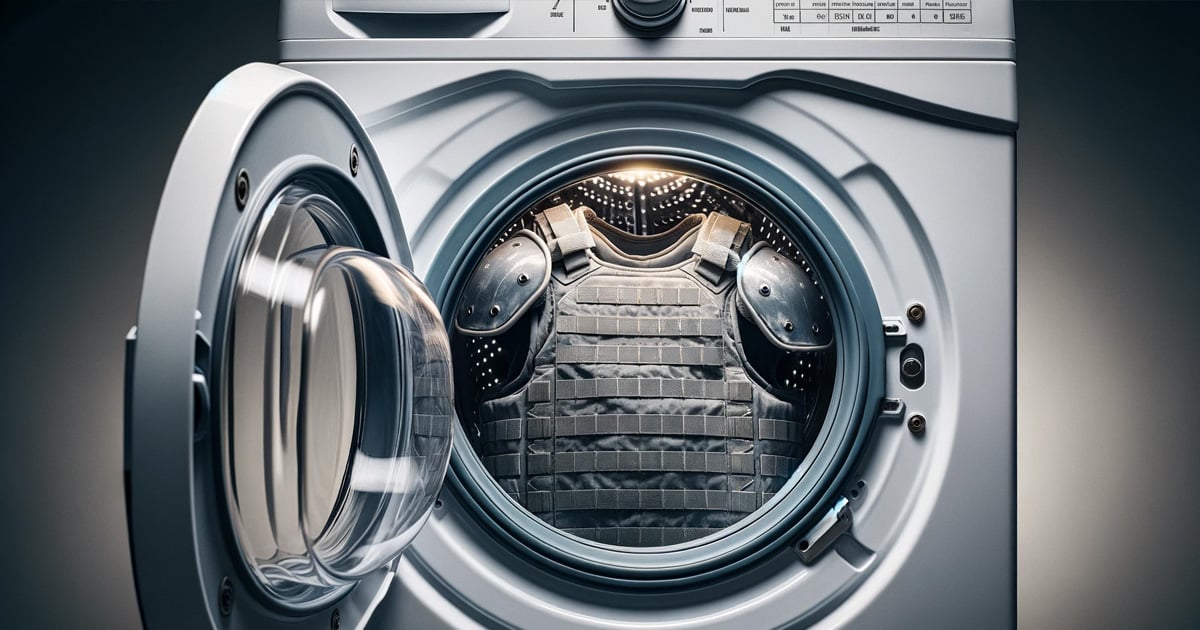Body armor is tough stuff. I’ve seen it stop everything from bullets to steel splinters from IED explosions. Rigid armor and some flexible armor will even stop knife blades. But it is not indestructible.
Both flexible and rigid body armor and the carriers it fits in benefit from proper care and maintenance. Body armor can cost as much as a decent handgun, so it’s wise to understand how to maintain and store it properly. Body armor owned by private citizens often spends most of its time in storage, so proper storage is especially important.
Body Armor for the Masses
Types of Body Armor
Body armor comes in two varieties: soft and hard or rigid. Soft armor has the advantage of being lighter and easier to conceal, but it will not stop most rifle rounds. Hard armor will stop many rifle rounds, but it is heavy and very difficult to conceal. They each have their own considerations for care and storage.
Soft Body Armor
When most people think of soft body armor, they think of Kevlar. But there is another material called UHMWPE that is gaining popularity that offers greater protection and weighs less.
Kevlar
Kevlar continues to be highly popular as the ‘bulletproof’ material in soft body armor. Its molecular structure makes it five times stronger than steel of the same weight, allowing it to dissipate and absorb the energy from incoming bullets. It is susceptible to damage from sunlight, moisture, and some chemicals. It also has a finite life span of around five years.
UHMWPE
Ultra-High Molecular Weight Polyethylene (UHMWPE) is incredibly strong due to its composition of very long polyethylene chains. It resists bullet penetration better than Kevlar and is significantly lighter, making it more comfortable for extended wear. Although it has some advantages over Kevlar, it is also more expensive. It has the same vulnerabilities to UV light and high temperatures as Kevlar and a life span of around five years.
Hard or Rigid Body Armor
Rigid body armor consists of hard plates that are worn in a carrier vest. Unlike soft body armor, rigid plates will stop most small arms rifle bullets. They also spread the impact out much better than soft armor, which reduces the seriousness of traumatic impact injury.
Both the vest and the plates need proper care after being worn and while in storage. Hard armor plates can be made of steel, ceramic, or UHMWPE, similar to that used in soft armor.
Steel Body Armor
Steel plates are the heaviest and most durable type of hard body armor. They offer good protection and have at least a 20-year lifespan. The greatest hazard to steel plates is rust and corrosion. Virtually all steel plates come from the factory with a waterproof coating to resist moisture.
Nevertheless, steel plates should be checked regularly for signs of moisture damage so that it can be addressed before it gets too serious. Steel plates should be stored in a dry, low-humidity environment to protect them from moisture.
Steel and steel core composite plates can be safely cleaned with a soft, damp cloth since they are given a waterproof coating at the factory. Ensure they are completely dried after cleaning before they are inserted back into the carrier.
Ceramic Body Armor
Ceramic armor plates are lighter than steel and offer excellent protection. They also prevent the spalling of bullets that can fragment on steel plates and send bits into your neck and groin. However, they are not as durable as steel plates and have an expiration date of around 5 to 10 years from the time they are manufactured. Avoid dropping them, and store them in a cool, dry place.
Ultra-High Molecular Weight Polyethylene (UHMWPE)
The same formula of Ultra-High Molecular Weight Polyethylene (UHMWPE) that is used for flexible armor is also used to manufacture rigid plates. They are light and resist moisture and UV light well, and typically have a lifespan of around five years. They should be stored in a cool, dry place. They are especially susceptible to high temperatures, which can degrade the polyethylene fibers.
Both ceramic and UHMWPE can be cleaned by wiping them down with a damp cloth or sponge. They really shouldn’t need much more than this to be well-maintained.
Things to Avoid
Some things are bad for armor across the board. Armor may be tough, but you should treat it with the same care and respect you treat your firearms.
Do Not Bend Soft Armor
All body armor should be stored flat. Never fold soft body armor. Avoid bending, flexing, compressing, or creasing soft armor panels in any way. Doing so can create weak spots by degrading the ballistic materials over time.
Do Not Drop Plates
Never drop your rigid armor plates, whether it’s in or out of the carrier. This is especially critical with ceramic or composite plates. Dropping them can create cracks or outright breaks that will impair their effectiveness. Steel plates resist drop damage better than ceramic, but it’s not a good idea to drop them either.
Protect Your Armor from Moisture
Storing your armor in a dry place is usually not too difficult. Keeping it dry while wearing it is a greater challenge. External factors like working in the rain, as well as internal factors like sweating on a hot day, can affect your armor.
Do Not Get It Soaking Wet
This may not always be possible, like getting caught in the rain while working. If possible, put a rain jacket on to protect your armor. Allowing everything to get soaked can cause mildew, corrosion, and rust to form.
If it does get soaked, be sure to remove the plates or soft insert from the carrier. Use absorbent material like paper towels to get the worst of the water off, then let everything dry thoroughly before putting it back together.
Wear a Shirt Under Your Armor
This may seem like a no-brainer, but always wear an absorbent shirt under your armor. Aside from being more comfortable, it will wick moisture and body oils from your vest. Perspiration has a lot of nasty stuff in it that is not good for your vest.
Dry Thoroughly Before Storage
It’s tempting after a hot day wearing heavy and uncomfortable body armor just to take it off and relax. I know. I’ve worn it 8+ hours a day in 100+ degree weather in Iraq and other places. But, like your gun, you may have to rely on your body armor to keep you alive. Taking the time to wipe it down to get the moisture off and store it properly comes under the heading of protecting your investment.
Basic Armor Care
As with anything, preventive maintenance is your friend. Putting in a little time to catch small things before they become big problems is time well spent.
Follow the Manufacturer’s Instructions
No matter what type or composition of armor you have, take the time to read and understand the manufacturer’s instructions. These will usually include cleaning and storage instructions, as well as guidance on what to look for and how to deal with small issues. If something unexpected happens to your armor, like some kind of chemical spilled on it or steel plates getting rusty, contact the manufacturer immediately for guidance on how to deal with it.
Inspect Regularly
Inspect all components of your armor regularly. Plate carriers should be checked for frayed straps, cracked or broken buckles, holes, or worn spots in the carrier itself.
Ballistic panel covers and inserts should be checked for signs of wear, such as cuts, tears, stitching separation, sealing problems, and worn or frayed fabric. Plates should be checked for nicks, cracks, and damage on the edges or corners. If you discover any flaws, contact the manufacturer for the best way to address them.
Cleaning Soft Armor and Plate Carriers
Kevlar vests and plate carriers inevitably gather dust and odors after being worn for long periods. Cleaning them is important and not all that difficult. Before you start cleaning a carrier vest, remove the armor plates and inserts. Also, remove all the waist and adjustment straps.
Hand Washing
You will need:
- Warm or cold water (never use hot water)
- Mild detergent or antibacterial soap (no solvents)
- Soft rags/sponge (a soft toothbrush can be used for difficult spots or stains)
I like to lay the vest out in the bottom of the bathtub. That way, it can spread out all the way, and there is a drain under it. Remove the plates, inserts, and straps first. Dip the sponge into the water solution and squeeze out excess liquid, then wipe the dirt off. Stubborn spots can be lightly scrubbed with a sponge or a soft toothbrush. Afterward, dip a fresh cloth or the sponge into clean water to get all the soap out. Never scrunch the carrier up in a bucket or tub. Always clean it lying flat.
It won’t hurt the carrier if you must use a little extra clean water to get all the soap out. It’s better than leaving the soap in it. Hang it up with tabs or on a hanger to dry naturally. Do not hang it in direct sunlight.
Machine Washing Body Armor
I have heard and seen recommendations that you can machine wash your carrier. I would never do this, but that’s just me. If you want to do it, make sure the manufacturer recommends it first. Use a front-loading machine on a gentle cycle with cold water and a mild detergent. Remove the armor inserts/plates and all straps and buckles first.
Straps
Never machine wash straps, and do not submerge them in water. Wash them with a sponge or damp cloth. You can use a little mild soap if you need to but ensure you have rinsed them well to get it all out. Dry them lying flat.
Armor Plates and Flexible Inserts
Plates and inserts should not be submerged in water, including never being put in a washing machine. Simply wipe them down with a damp cloth or sponge. A little mild detergent is fine, but be sure to get all the soap residue off.
Drying Body Armor
Body armor plates, inserts, and carriers should be air-dried. Lay them out flat to dry, turning them over if necessary. Carriers and vests can be hung to dry on a hanger or armor tree if space is limited, but ensure it is hung properly in the shape you want it to be in when it is dry. Keep everything out of direct sunlight, as UV rays can harm materials such as Kevlar and polyethylene.
Spraying Body Armor
Admittedly, body armor and tactical vests can start to smell a little funky after being worn for hours in hot or humid conditions. Avoid the temptation to spray it with deodorant or Febreze, as they contain chemicals that can damage the ballistic material in your armor.
Instead, use a deodorizing spray specifically made for use on body armor and other tactical gear. A couple of examples are Arrest My Vest and Refresher – Professional Gear Odor Eliminator. These will help kill odor-causing bacteria without harming your armor.
Storage and Transportation
As I mentioned earlier, privately owned body armor spends most of its time in storage. That makes it critical that it is stored properly.
When Storing Your Armor:
- Ensure that the vest lies flat. Folding or rolling flexible armor can damage its structure and effectiveness.
- Do not store in direct sunlight.
- Keep your body armor free from dirt and contaminants that could deteriorate the armor or carrier.
- Ensure that your armor is dry before storing. Moisture can cause mildew on carriers and weaken the materials.
Things to Avoid
- Don’t store armor in a low airflow environment where moisture can accumulate and promote mildew.
- Avoid storing in extreme temperatures, like the trunk of a car.
- Don’t hang armor by the carrier or adjustment straps. This can cause them to stretch and lose their shape.
- Don’t bunch or fold soft body armor. This can damage the internal structure.
- Do not place heavy items on top of your armor.
Considerations When Transporting Your Armor
Always transport your armor lying flat. Never fold it or cram it into a duffle back or carryall. Never stack anything on top of it. Do not lay it out where direct sunlight can hit it, as UV rays can cause deterioration of flexible armor. Cover the armor with a jacket or other opaque cover.
Body armor should not be left inside of a closed vehicle on a hot or sunny day. Extreme heat can cause deterioration of Kevlar and polyurethane armor. If you have no other option but to leave armor in a vehicle, try to park it in the shade.
Last Words
This has been a general rundown of how to care for body armor. For detailed instructions, go to the manufacturer’s website. Armor manufacturers are among the most conscientious of all manufacturers, and they will go the extra mile to support and assist you.
In General, treat your armor with the same respect you treat anything else your life may depend on. Just as you take the time to care for your gun properly, put the same effort into caring for your armor.
Read the original story: Caring for Body Armor









